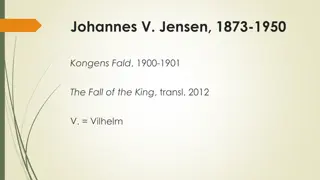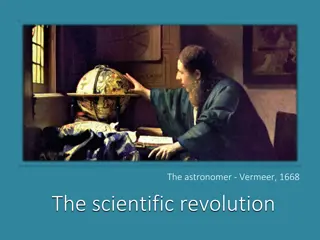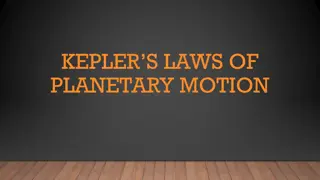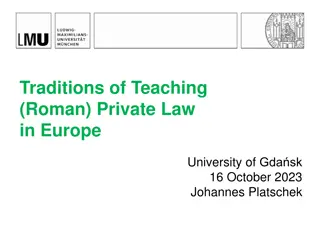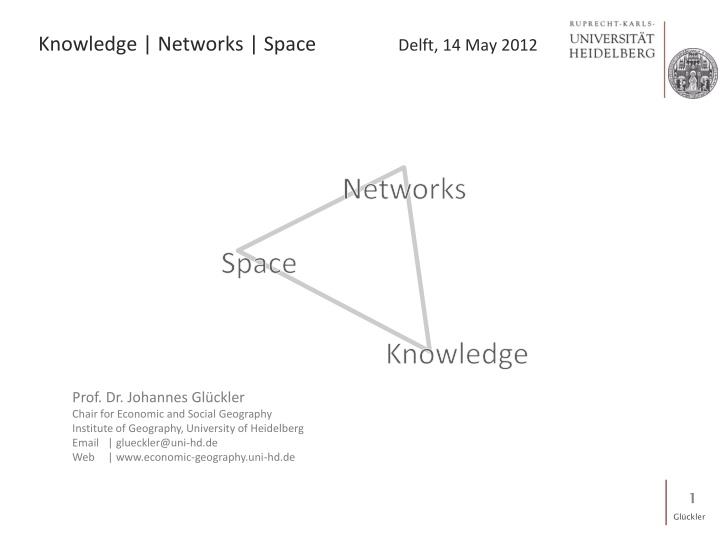
Network Theory and Its Implications in Geography
Explore the increasing popularity of networks in geography through the lens of network theory. Dive into discussions on the role of networks in shaping knowledge, space, and social behavior, as well as the various network theories and their impact on innovation, cooperation, and governance. Delve into the concept of social networks and their interpretation of social behavior, all while contemplating the relational revolution and the fortification of geography through connectivity.
Download Presentation

Please find below an Image/Link to download the presentation.
The content on the website is provided AS IS for your information and personal use only. It may not be sold, licensed, or shared on other websites without obtaining consent from the author. If you encounter any issues during the download, it is possible that the publisher has removed the file from their server.
You are allowed to download the files provided on this website for personal or commercial use, subject to the condition that they are used lawfully. All files are the property of their respective owners.
The content on the website is provided AS IS for your information and personal use only. It may not be sold, licensed, or shared on other websites without obtaining consent from the author.
E N D
Presentation Transcript
Knowledge | Networks | Space Delft, 14 May 2012 Networks Space Knowledge Prof. Dr. Johannes Gl ckler Chair for Economic and Social Geography Institute of Geography, University of Heidelberg Email | glueckler@uni-hd.de Web | www.economic-geography.uni-hd.de 1 Gl ckler
Buzzwords Every 6th session of this conference has network in its title (20/121) Networks Every 8th paper of this conference has network in its title (44/364). Space rank keyword 1 region* 2 space* 3 city/cities 4 planning 5 governance 6 development 7 network* 8 innovat* 9 territor* 10 knowledge count 256 85 79 72 68 67 64 62 57 48 Knowledge 2 Gl ckler Number of times that a keyword appears in the 2012 RSA annual conference program
Increasing popularity of networks in geography 3 Gl ckler Own research based on queries with JSTOR, April 2012
Agenda 1. What is network theory? Toward a full relational revolution 2. Network theories of knowledge & geography Contingencies of an explanatory triad 3. Beyond connectivity Fortifying geography 4. Conclusion 4 Gl ckler
A social network is a specific set of linkages among a defined set of persons, with the additional property that the characteristics of these linkages as a whole may be used to interpret the social behavior of the persons involved (Mitchell 1969, 2) 5 Mitchell, J. C. (1969) The concept and use of social networks. In J. C. Mitchell (ed.) Social Networks in Urban Situations. Analyses of Personal Relationships in Central African Towns. Manchester: Manchester University Press, 1-50. Gl ckler
Networks: relational rhetoric, atomistic analysis? 6 Gl ckler Own research based on queries with EBSCO and individual electronic journal archives, April 2012
What is network theory? Capitalization = flow-based theories of innovation (e.g. structural holes) Social outcomes Model Success Choice Cooperation = coordination- based theories of innovation (network governance, organized networks) Flow (ties as pipes) Capitalization Contagion Coordination (ties as bonds) Cooperation Convergence 7 Gl ckler Borgatti SP, Halgin DS (2011) On network theory. Organization Science:
Structural hole theory: contacts and careers 8 Gl ckler Burt, R. S. (2004): Structural holes and good ideas. American Journal of Sociology 110, S. 349-399.
Network theory and theory of networks Network theory Dependent variable Example: centrality increases innovativeness Non-network variable as outcome network variable as outcome Independent variable Theory of networks Example: legitimacy or resource endowment drives centrality Non-network theory (B) Theory of networks Non-network variable as antecedent Network theory of networks (A) Network theory (C) Network theory of networks Example: Point connectivity predicts future tie formation Network variable as antecedent 9 Gl ckler Borgatti SP, Halgin DS (2011) On network theory. Organization Science:
Agenda 1. What is network theory? Toward a full relational revolution 2. Network theories of knowledge & geography Contingencies of an explanatory triad 3. Beyond connectivity Fortifying geography 4. Conclusion 10 Gl ckler
Networks affect knowledge (and innovation) Existence of ties Number of ties Membership in a network Networks Strength of ties Space + Strong ties Weak ties Position Centrality Prestige Autonomy Out-group orientation Between core and periphery Knowledge Burt RS (1992) Structural Holes: The Social Structure of Competition. Cambridge (MA), London: Harvard University Press.; Granovetter M (1973) The strength of weak ties. American Journal of Sociology 78: 1360-1380; Krackhardt D, Stern RN (1988) Informal networks and organizational crises: An experimental simulation. Social Psychology Quarterly 51 (2): 123-140; Powell WW, Koput KW, Smith-Doerr L (1996) Interorganizational collaboration and the locus of innovation: networks of learning in biotechnology. Administrative Science Quarterly 41 (1): 116-145 11 Gl ckler
(i) Geography of knowledge intellectual breakthroughs must cross hallways and streets more easily than oceans and continents (Glaeser et al. 1992: 1126). Networks Space Patent citation analyses demonstrate that technological development is sticky to regions. + Knowledge 12 Glaeser EL, Kallal HD, Scheinkman JA, Shleifer A (1992) Growth in cities. The Journal of Political Economy 100 (6): 1126-1152; Jaffe AB, Trajtenberg M, Henderson R (1993) Geographic localization of knowledge spillovers as evidenced by patent citations. Quarterly Journal of Economics 108: 577-598; Thompson P, Fox-Kean M (2005) Patent citations and the geography of knowledge spillovers: A reassessment? American Economic Review 95 (1): 450-460 Gl ckler
(ii) Geography affects networks A geographical theory of networks (in compliance with Borgatti/Hardin) Networks + Physical proximity increases the likelihood for social relations and information exchange Space Research on network evolution confirms geographically nested growth of network linkages on longitudinal data. Knowledge Allen T (1977) Managing the Flow of Technology: Technology transfer and the Dissemination of Technological Information within the Research and Development Organization. Cambridge, MA: MIT Press. Powell WW, White D, Koput KW, Owen-Smith J (2005) Network dynamics and field evolution: The growth of interorganizational collaboration in the life sciences. American Journal of Sociology 110 (4): 1132-1205; Zipf GK (1949) Human Behaviour and the Principle of Least Effort. Cambridge, Mass.: Addison-Wesley Press. 13 Gl ckler
(iii) Geography moderates network effects on knowledge Example: Alliances in bio- technology and firm innovative- ness (Owen-Smith/Powell 2004): Networks Network centrality is an important factor of innovativeness only in the global network, but insignificant in the regional cluster. - + Space Firms connected to the local network have equal propensities to innovate independently from the centrality of their position in the network. Knowledge 14 Owen-Smith J, Powell WW (2004) Knowledge networks as channels and conduits: The effects of spillovers in the Boston biotechnology community. Organization Science 15 (1): 5-21; Whittington KB, Owen-Smith J, Powell WW (2009) Networks, propinquity, and innovation in knowledge-intensive industries. Administrative Science Quarterly 54 (1): 90-122 Gl ckler
(iv) Networks moderate spatial effects on knowledge Accepted state of knowledge: information transfer and knowledge spillovers decay with geographical distance Networks + Informal and formal networks of relations between distributed organizational units clearly moderate the association between technology transfer and geography Space - Knowledge Network relationships help bridging distance 15 Bell GG, Zaheer A (2007) Geography, networks, and knowledge flow. Organization Science 18 (6): 955-972; Gl ckler J (2006) A relational assessment of international market entry in management consulting. Journal of Economic Geography 6: 369-393; Hansen MT, Lovas B (2004) How do multinational companies leverage technological competencies? Moving from single to interdependent explanations. Strategic Management Journal 25: 801-821 Gl ckler
(iv) Networks mediate spatial effects on knowledge Almeida/Kogut find that spillovers vary across regions and those regions with the strongest spillovers in technological development were the ones where job mobility was most restricted to intraregional job moves. Networks + Space + Rosenkopf/Almeida show that inventor mobility increases inter-firm knowledge transfer (patent citations) independent of geography. 0 Knowledge Borgatti/Foster find that when knowing someone and accessibility of the person are controlled, proximity has no statistical effect on information transfer. Mediation implies that the mediated variable (space) predicts the mediating variables as well as the dependent variable (e.g. innovation), and that the coefficient for the mediated variable is insignificant when the mediators are included in the model. Almeida P, Kogut B (1999) Localization of knowledge and the mobility of engineers in regional networks. Management Science 45: 905-917; Breschi S, Lissoni F (2009) Mobility of skilled workers and co-invention networks: An anatomy of localized knowledge flows. Journal of Economic Geography 9 (4): 439- 468; Borgatti SP, Foster PC (2003) The network paradigm in organizational research: A review and typology. Journal of Management 29 (6): 991-1013; Rosenkopf L, Almeida P (2003) Overcoming local search through alliances and mobility. Management Science 49 (6): 751-766 16 Gl ckler
Agenda 1. What is network theory? Toward a full relational revolution 2. Network theories of knowledge & geography Contingencies of an explanatory triad 3. Beyond connectivity Fortifying geography 4. Conclusion 17 Gl ckler
Accounting for ambivalent evidence Empirics suggest: Ambivalent evidence about the explanatory triad knowledge, networks and space Reason 1: Variance in research designs, methodology and measures Measures of networks (Level of actors, kinds of relations) (Lack of) variations in what is conceived as knowledge (patents) Neglect of intervening conditions: tacitness, property, complexity, causal ambiguity of knowledge Reason 2: Does knowledge flow really respect the paths of a communication network? Even fully isolated firms are found innovative when located in close proximity (Whittington et al 2009) Serendipity, buzz, noise etc. (Bathelt et al. 2004) Toward non-relational forms of learning 18 Bathelt H, Malmberg A, Maskell P (2004) Clusters and knowledge: Local buzz, global pipelines and the process of knowledge creation. Progress in Human Geography 28: 31-56; Whittington KB, Owen-Smith J, Powell WW (2009) Networks, propinquity, and innovation in knowledge-intensive industries. Administrative Science Quarterly 54 (1): 90-122 Gl ckler
Two kinds of collective learning Rival learning Collaborative learning = non-relational learning Learning without cooperation or the establishment of real social or organizational relations. Unfriendly imitation = reproduction of a practice where the source firm is unaware or even disapproves of this reproduction. Examples: poaching, buzz, observation, reverse engineering, industrial espionage = Learning by interacting. Learning occurs through collaborative knowledge creation (alliance) and friendly imitation. Friendly imitation = transmission of an existing practice to another firm based on the agreement or active cooperation by the source firm. Examples: strategic alliances, financial syndication, research consortia Imitation = unilateral absorption of existing solutions from one firm by another 19 Malmberg A, Maskell P (2002) The elusive concept of localization economies: Towards a knowledge-based theory of spatial clustering. Environment and Planning A 34: 429-449; Powell WW, Koput KW, Smith-Doerr L (1996) Interorganizational collaboration and the locus of innovation: networks of learning in biotechnology. Administrative Science Quarterly 41 (1): 116-145 Gl ckler
20 Gl ckler
Conclusion Future research should bridge the structural hole between geography and network studies. The two literatures hardly ever make any reference to each other. Connectivity and copresence complement each other: Networks help bridge distances; proximity helps bridge disconnection. Non-interactive and non-relational forms of learning are a challenge to the connectivity paradigm and fortify the role of geography, though much more research is needed. Connectivity and culture. Relational theory tries to integrate structural theory, which is interested in relationship patterns of social networks, with cultural theories that focus on the construction of meaning in these relations. Pursue the how instead of the why to capture contingencies in the relation between knowledge, networks and space. 21 Hallen BL, Eisenhardt KM (2012) Catalyzing strategies and efficient tie formation: How entrepreneurial firms obtain investment ties. Academy of Management Journal 55: 35-70; Martin JA, Eisenhardt KM (2010) Rewiring: Cross-business-unit collaboration in multibusiness organizations. Academy of Management Journal 53 (2): 265-301 Gl ckler
A relational perspective: A half-hearted revolution? The anticategorical imperative (Emirbayer and Goodwin 1994) A relational perspective focuses on individual and collective opportunities for action and conceives these opportunities as enabled through the specific context (meaning) and structure (connectivity) of social relations Network as object of knowledge Regional networks, strategic networks, project networks, network organizations Network as theory Complex approaches: Actor-Network Theory, rhizome theory, theory of publics and switching between netdoms Network as methodology Social network analysis Bathelt H, Gl ckler J (2011) The Relational Economy. Geographies of Knowing and Learning. Oxford: Oxford University Press.; Emirbayer M, Goodwin J (1994) Network analysis, culture, and the problem of agency. American Journal of Sociology 99 (6): 1411- 1454; Sunley P (2008) Relational economic geography: A partial understanding or a new paradigm? Economic Geography 84 (1): 1-26; Yeung HW-c (2005) Rethinking relational economic geography. Transactions of the Institute of British Geographers 30 (1): 37-51 22 Gl ckler
Networks of competitive advantage Anti-poaching schemes are an example of collusion, where competitors cooperate to avoid high labour cost for talented personnel Network structures Network modalities Directly connected Structurally equivalent Equitable Exchange Collaborative Collusion For the secrecy of the agreement there is no interaction between firms where in reality there are agreements. Opportunistic Exploitation Competition 23 Galaskiewicz J, Zaheer A (1999) Networks of competitive advantage. In: Knoke D, Andrews S (Hg) Research in the Sociology of Organizations. Greenwich (CT): JAI Press, S. 237-261 Gl ckler


